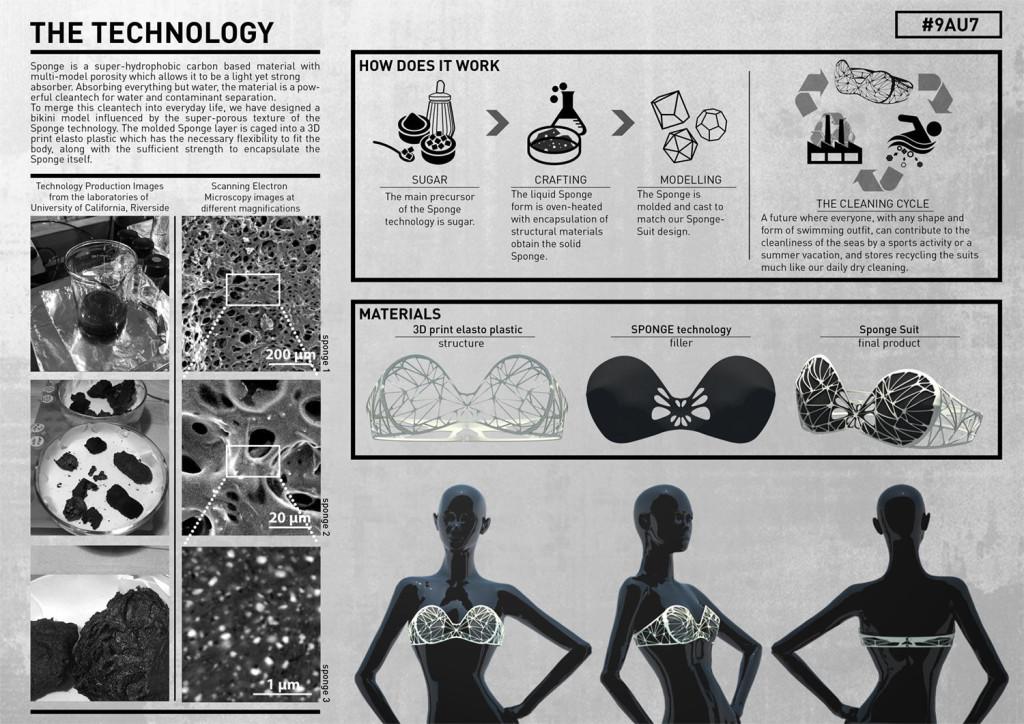 Mihri Ozkan and her husband, Cengiz, aren’t your typical fashion designers. In fact, they’re not fashion designers at all–but they recently created a surprisingly chic bathing suit that’s intended to do far more than complement its wearer’s body. This partly 3D printed bathing suit is designed to clean the water in which it’s immersed.
Mihri Ozkan and her husband, Cengiz, aren’t your typical fashion designers. In fact, they’re not fashion designers at all–but they recently created a surprisingly chic bathing suit that’s intended to do far more than complement its wearer’s body. This partly 3D printed bathing suit is designed to clean the water in which it’s immersed.
The Ozkans designed the Sponge Suit bikini not as an end in itself so much as to showcase the material from which it is made. It sounds absolutely bonkers–wearing a sponge bikini that absorbs water seems a bit like strapping on a couple of sandbags when you’re getting ready to fly. However, the material the suit is made from actually repels water while it does its job, which is to clean the water of pollutants.
Dr. Mihri Ozkan is a Professor of Electrical Engineering and a cooperating faculty member in the Bioengineering, Chemistry and Material Science Program at the University of California Riverside. When Dr. Ozkan isn’t conceiving of ingenious ways of cleaning up the world’s polluted oceans, her research activities are, says her webpage on the UC Riverside website, “focused on the development of industrial scale advanced energy storage devices, such as batteries and supercapacitors.”
Dr. Ozkan, her husband, Cengiz who is also a Professor of Electrical Engineering with the Bourns College of Engineering at UC Riverside, and two PhD students, Daisy Patino and Hamed Bay, created the sponge material and the Sponge Suit bikini, which recently won first prize in the Reshape15: Wearable Technology Competition. Reshape, says the organization’s website, is an “online platform promoting research, education and production of digital ideas.” It also offers designers an online market in which to sell their products–or their ideas, which can be prototyped by makers in the Reshape community.
The material from which the eco-conscious bathing suit is made is called–probably not surprisingly–Sponge. In particular, it is designed to clean up chemical and oil spills and also to desalinate water. It is an extremely porous carbon material that, in addition to soaking up toxins and repelling water, is surprisingly lightweight and flexible. It earns its name as, incredibly, it can absorb more or less (it varies based on the density of whatever it is absorbing) 25 times its weight.
“This is a super material,” explained Dr. Ozkan, “that is not harmful to the environment and very cost effective to produce.”
While the idea for Sponge is Dr. Ozkan’s and her team’s, the concept of the Sponge Suit must be credited to Eray Carbajo, an architecture and design firm based in Istanbul and New York City. Dr. Ozkan and her lab team worked with the Inanc Eray, Gonzalo Carbajo, and Pinar Guvenc of the firm to develop the Sponge Suit into a 3D printable design based, said its Eray Carbajo creators, on “various iterations of the same undulating form.”
As for the 3D printing process, they elaborated:
“The filler amount and the allocation were identified by creating several design alternatives, considering the form and the ergonomics of the human body, while pushing the limits in translucent swimwear design.”
 The end result is an ultra-chic Sponge Suit bikini consisting of a 3D-printed flexible plastic or “elastomer” frame and a Sponge insert. The entire bikini weighs only 1.9oz or 54 grams and the material is 2mm thick. The insert–the Sponge material–can be used 20 times before it begins losing its capacity to absorb contaminants, which end up in the material and never make contact with the skin of the bikini’s wearer.
The end result is an ultra-chic Sponge Suit bikini consisting of a 3D-printed flexible plastic or “elastomer” frame and a Sponge insert. The entire bikini weighs only 1.9oz or 54 grams and the material is 2mm thick. The insert–the Sponge material–can be used 20 times before it begins losing its capacity to absorb contaminants, which end up in the material and never make contact with the skin of the bikini’s wearer.
Amazingly, the Sponge material does not release the toxins it absorbs unless it is subjected to temperatures over 1,000°C (or 1,832°F). It probably goes without saying that you’d have a lot more to worry about in heat that high than your skin coming into contact with pollutants.
The bathing suit aside, the Sponge material would not be especially costly to produce in great quantities. According to Dr. Ozkan’s team, “the main precursor” for creating the material is sugar. Thus, they pointed out, the cost per gram of Sponge is “roughly 15 cents, a reducible cost when achieving economies of scale.”
The combined teams–the scientists and the designers–see a bright future for beachwear that does more than just look good:
“This design can be developed into different outfits: bathing suits, mayokini, swimming caps. Reprogrammability, recyclability and affordability are intriguing properties of the technology, allowing room for further research and development in clean-tech wearable. We aim for a future where everyone, with any shape and form of swimming outfit, can contribute to the cleanliness of the seas by a sports activity or simply a leisurely summer vacation.”
What are your thoughts on this new type of purposeful fashion? Let us know in the 3D Printed Bikini forum thread on 3DPB.com.
Subscribe to Our Email Newsletter
Stay up-to-date on all the latest news from the 3D printing industry and receive information and offers from third party vendors.
You May Also Like
Profiling a Construction 3D Printing Pioneer: US Army Corps of Engineers’ Megan Kreiger
The world of construction 3D printing is still so new that the true experts can probably be counted on two hands. Among them is Megan Kreiger, Portfolio Manager of Additive...
US Army Corps of Engineers Taps Lincoln Electric & Eaton for Largest 3D Printed US Civil Works Part
The Soo Locks sit on the US-Canadian border, enabling maritime travel between Lake Superior and Lake Huron, from which ships can reach the rest of the Great Lakes. Crafts carrying...
Construction 3D Printing CEO Reflects on Being Female in Construction
Natalie Wadley, CEO of ChangeMaker3D, could hear the words of her daughter sitting next to her resounding in her head. “Mum, MUM, you’ve won!” Wadley had just won the prestigious...
1Print to Commercialize 3D Printed Coastal Resilience Solutions
1Print, a company that specializes in deploying additive construction (AC) for infrastructure projects, has entered an agreement with the University of Miami (UM) to accelerate commercialization of the SEAHIVE shoreline...





























